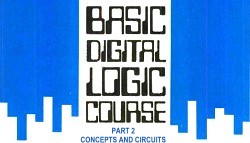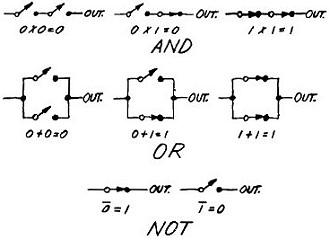|
November 1974 Popular Electronics
 Table of Contents Table of Contents
Wax nostalgic about and learn from the history of early electronics. See articles
from
Popular Electronics,
published October 1954 - April 1985. All copyrights are hereby acknowledged.
|
English mathematician
George Boole
published his "Formal Logic" syllogism system of deductive reasoning in 1847. Fellow countryman
Augustus De Morgan followed on Boole's work to develop the basic
combinational logic rules the AND gates, OR gates, and NOT (negation) operators.
What has become known as Boolean algebra and De Morgan's theorem forms the fundamental
foundation of everything related to digital logic. This second in a three-part series
from a 1974 issue of Popular Electronics introduces both concepts at a
beginner's level. Part 3 will present flip-flops and an overview of how all the
parts come together to build a simple computer.
See Part 1,
Part 2,
and Part 3.
Basic Digital Logic Course - Part 2: Concepts and Circuits
 By Forrest M. Mims and H. Edward Roberts By Forrest M. Mims and H. Edward Roberts
In part 1 of our short course in digital logic, we discussed the binary number
system, binary arithmetic, and the octal number system. In Part 2, we are concerned
with logic concepts and circuits.
Boolean Logic
In 1847, George Boole, a British mathematician, published his Mathematical Analysis
of Logic. This booklet did not equate mathematics with logic, but it did demonstrate
how any logic statement can be analyzed with basic mathematical relationships. Boole
published a much longer and refined version of his theory of logic in 1854. To this
day, all practical digital computers and countless other electronic digital circuits
are based on the concepts pioneered by Boole.
Boolean logic (or algebra) makes the important assumption that a logic statement
is either true or false. Since electronic circuits can easily be made to operate
in either of two states, on or off, it is convenient to equate "true" with "on"
and "false" with "off." Similarly, we can equate the binary 1 with on and the binary
0 with off. With the foregoing in mind, let us review Boole's basic logic concepts.

Fig. 1 - Switches are arranged to illustrate three basic digital
electronic functions.
The mathematical explanation of logic put forth by Boole can be simplified into
three basic logic functions: AND, OR, and NOT. The AND function requires that one
logic state or condition and at least one other be true before the entire statement
is true. The OR function requires that one logic state or at least one other be
true before the entire statement is true. The NOT function simply reverses a statement
from true to false, or vice versa. Electronic NOT circuits are commonly referred
to as "inverters" because their function is to invert the polarity of the signal.
The above definitions can be tabulated into a table such as shown in Fig. 1.
Such a table is useful in showing the relationships among Boole's three logic functions
and their electronic and arithmetic counterparts. This type of table is sometimes
called a "truth table" since it sets forth the various logic conditions for which
each statement is true. Generally, truth tables are arranged in a more compact form
similar to those shown for the three basic logic functions in Fig. 2.
Truth tables can be created for any logic function. Specification sheets for
digital logic circuits almost always include a truth table.
Logic Symbols. Boolean logic statements can be implemented by simply writing
them on paper, using alphabetic symbols to correspond to "true" and "false" conditions.
Electronic logic diagrams, however, are much easier to design and interpret if a
sort of block diagram of the circuit is presented. For this reason, standardized
logic-block symbols have been devised for the three basic logic functions. They
are shown in Fig. 2.
Compound Logic Circuits
Two circuit combinations (the NOT-AND and the NOT-OR) are used so frequently
that they are treated as basic logic elements and given their own logic symbols
and truth tables.

Fig. 2 - AND, OR, and NOT symbols are shown with truth tables.

Fig. 3 - NAND and NOR symbols with associated truth tables.
When the AND function is followed by a NOT statement, the meaning of the AND
function is reversed to NOT-AND, commonly called a NAND function. Similarly, when
the OR function is followed by a NOT statement, the meaning of the OR statement
is reversed to NOT-OR, commonly referred to as a NOR function. The logic symbols
and truth tables for the NAND and NOR functions are shown in Fig. 3.
DeMorgan's Theorem
About the same time Boole developed his logic theories, Augustus DeMorgan was
also developing some fundamental theories of logic. His most important contribution,
known as DeMorgan's Theorem, relates the AND, OR, and NOT functions as follows:
A + B=
A x
B.
A x B
= A +
B.
The arithmetic symbols + and x mean OR and AND, respectively. The bar, or vinculum,
over a letter indicates the NOT function. Thus
A means NOT A.
The importance of DeMorgan's Theorem is that an AND circuit containing a NOT
at each input corresponds to an OR circuit followed by a NOT. Similarly, an OR circuit
with a NOT at each input corresponds to an AND circuit followed by a NOT. This does
not equate the NAND and NOR functions, but it does mean that NAND circuits can be
used to implement NOR functions, and vice versa.
Complex Logic Systems
Logic systems that contain three or more basic logic elements are termed "complex."
One of the simplest of the complex logic systems is the EXCLUSIVE OR (sometimes
written XOR) function shown diagrammatically in Fig. 4. From the truth table, note
that this function is identical to the OR function with one important exception:
A true condition exists only when one or the other condition, but not both, is true.
The EXCLUSIVE OR function completes the connection between Boolean logic, the
binary number system, and electronic switching circuits, for it can be used to add
two binary bits. To see how this is accomplished, assume a logic 1 at input A and
a logic 0 at input B in the EXCLUSIVE OR circuit shown in Fig. 4. Since only one
input is enabled (input A), AND circuit 1 does not turn on. Hence, a 0 is present
at the CARRY output. OR circuit 1 does turn on, since only one input need be present.
Since the NOT circuit inverts the 0 from AND circuit 1 into a logic 1, AND circuit
1 has two input signals and is therefore turned on. The result is a logic 1 at the
sum output. (The circuit has added 0 + 1 to obtain 1.)

Fig. 4 - Logic array for XOR circuit.
The EXCLUSIVE OR circuit is often called a "half-adder." Try verifying its operation
yourself by adding 1 + 1 in binary.
Practical Logic Circuits. Figure 1 demonstrated how simple switching circuits
can be used to implement each basic logic function. However, it is usually not practical
to employ switches in real systems. Instead, transistors, SCR's, tunnel diodes,
or other solid-state switches are employed.
The most commonly used switch in digital electronics is the transistor. Relatively
simple circuits that combine diodes, resistors, and transistors can be used to implement
the AND, OR, and NOT functions. Thanks to integrated circuit (IC) technology, several
or even dozens of individual logic circuits can be placed on a single compact silicon
chip. Resistor-transistor logic (RTL) was once the most popular type of digital
IC, but it has been largely replaced by the more noise-immune transistor-transistor
logic (TTL) type.
In recent years, field-effect transistor (FET) technology has been adapted to
integrated logic circuits of amazing complexity. By insulating the gate of a FET
with a layer of silicon dioxide, extremely high impedances are made possible. The
result is a logic circuit that requires microamperes or nanoamperes of operating
current at relatively low voltages.
Insulated-gate fabrication techniques are collectively known as MOS (for metal
oxide semiconductor) technology. Since MOS transistors are unipolar (p- or n-type)
and do not require separate p and n sections like conventional bipolar pnp and npn
transistors, MOS IC's can have a much higher component density than most conventional
IC's. The result is large-scale integration (LSI). So, the next time you read or
hear the phrase "MOS LSI," you will know that it refers to a large scale integrated
circuit employing metal oxide semiconductors.
Posted September 17, 2019
|








 By Forrest M. Mims and H. Edward Roberts
By Forrest M. Mims and H. Edward Roberts 



